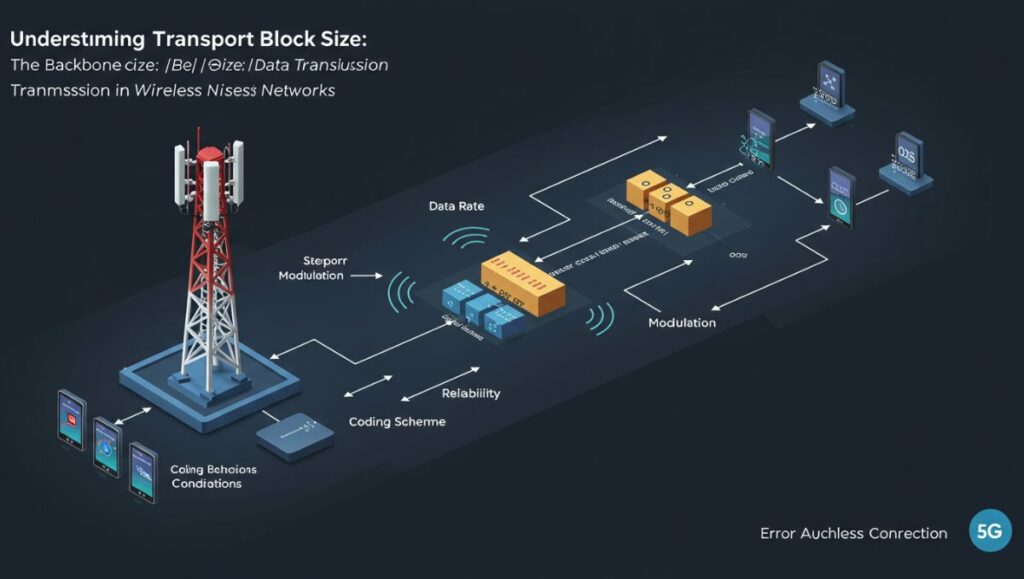In wireless communication systems such as LTE (Long Term Evolution) and 5G NR (New Radio), the Transport Block Size (TBS) plays a crucial role in determining how much data can be transmitted over the air interface in a single scheduling interval.
Simply put, the transport block size defines the maximum number of bits that can be carried in a transport block — a unit of data delivered by the MAC (Medium Access Control) layer to the physical (PHY) layer for transmission.
Getting the TBS right ensures efficient use of bandwidth, minimizes retransmissions, and directly affects system throughput and latency.
The Role of Transport Block Size in Wireless Communication
In cellular systems, data doesn’t travel as one continuous stream. Instead, it’s split into transport blocks, each carrying a chunk of data that the network transmits in one Transmission Time Interval (TTI).
Each transport block undergoes several processes — coding, modulation, mapping, and transmission — to ensure reliable delivery over a potentially noisy wireless channel.
Here’s where TBS becomes important: it defines the payload size that fits within the allocated radio resources, balancing efficiency (using spectrum effectively) and reliability (avoiding errors).
A well-calculated TBS ensures that:
-
The radio link uses the channel efficiently.
-
The receiver can decode data accurately.
-
The system maintains stable throughput even in changing network conditions.
Key Parameters Affecting Transport Block Size
The Transport Block Size is not fixed — it depends on several key parameters defined by the network scheduler and physical layer configuration. The main influencing factors are:
-
Modulation and Coding Scheme (MCS):
Determines the data rate and robustness of transmission. Higher MCS (e.g., 64-QAM or 256-QAM) allows larger TBS, while lower MCS (e.g., QPSK) limits it for reliability. -
Number of Resource Blocks (RBs):
Defines how much bandwidth is allocated to the user. More resource blocks mean a larger TBS capacity. -
Number of Layers (MIMO configuration):
Multiple Input Multiple Output (MIMO) systems can transmit multiple transport blocks in parallel across spatial layers. -
Transmission Time Interval (TTI) or Slot Duration:
Shorter TTIs (as in 5G) allow faster scheduling but smaller TBS per interval, optimizing latency rather than volume. -
Overhead and Control Information:
Physical control channels and signaling consume part of the resource allocation, affecting the net TBS available for user data.
Transport Block Size in LTE
In LTE, the calculation of TBS follows a standardized process defined in 3GPP TS 36.213.
Here’s the simplified procedure:
-
The scheduler assigns a certain number of Resource Blocks (N<sub>RB</sub>) and Modulation and Coding Scheme (MCS index).
-
Based on these, the Transport Block Size Index (I<sub>TBS</sub>) is determined from standardized lookup tables.
-
The TBS value corresponding to (N<sub>RB</sub>, I<sub>TBS</sub>) is retrieved from the 3GPP-defined Transport Block Size Table.
The resulting TBS determines how many bits of user data can be sent during one subframe (1 millisecond).
For example:
-
A user allocated 20 RBs with an MCS index of 10 might have a TBS of 4408 bits.
-
A user allocated 100 RBs with MCS 28 could have a TBS exceeding 75,000 bits.
This standardized process ensures that every LTE network and device calculates TBS consistently for interoperability.
Transport Block Size in 5G NR
With the introduction of 5G New Radio, the concept of Transport Block Size remains, but its flexibility has dramatically increased.
5G supports:
-
Variable subcarrier spacing (SCS): 15 kHz to 240 kHz
-
Dynamic slot durations (mini-slots and flexible TTIs)
-
Higher MIMO layers and massive bandwidths
The TBS in 5G is defined by 3GPP TS 38.214, and its calculation involves additional parameters:
-
Code rate and MCS index (ranging from 0 to 27 for data channels).
-
Number of allocated resource elements (REs) considering overhead.
-
Number of codewords, since 5G can transmit one or two transport blocks per user (depending on MIMO configuration).
-
Scaling factors for control information, reference signals, and HARQ feedback.
In simpler terms — 5G NR allows extremely high TBS values (hundreds of kilobits per TTI), enabling ultra-fast data throughput while maintaining flexibility for low-latency and massive machine-type communications.
TBS Calculation Example (Simplified)
Let’s illustrate how Transport Block Size is derived conceptually:
-
Scheduler allocates 10 resource blocks to a user.
-
The MCS index chosen corresponds to a modulation of 16-QAM and a coding rate of 0.5.
-
Using 3GPP tables, this gives an I<sub>TBS</sub> value of 12.
-
The TBS table shows that for 10 RBs and I<sub>TBS</sub> = 12, the TBS = 3264 bits.
Thus, the physical layer will transmit 3,264 bits of data in that subframe for that user — before adding coding, modulation, and signaling overhead.
Why Transport Block Size Matters
Optimizing TBS directly impacts network performance.
1. Throughput Efficiency
The size determines how much user data can be transmitted per slot. Too small, and bandwidth is wasted. Too large, and errors increase due to decoding difficulty.
2. Latency and Scheduling Flexibility
In 5G, smaller transport blocks improve responsiveness for real-time applications (e.g., VR, autonomous vehicles).
3. Error Correction and Retransmissions
TBS affects Hybrid Automatic Repeat Request (HARQ) processes. Correctly sized blocks minimize retransmissions and conserve radio resources.
4. System Optimization and Capacity Planning
Network engineers use TBS calculations for link adaptation, capacity simulations, and real-world deployment tuning.
Simply put — TBS is a balancing act between speed, reliability, and efficiency.
Transport Block Size Tables (3GPP Reference)
The 3GPP standard tables define exact TBS values for combinations of resource blocks and I<sub>TBS</sub> indices.
These tables are available in:
-
LTE: 3GPP TS 36.213, Annex 7.1.7.2.1
-
5G NR: 3GPP TS 38.214, Table 5.1.3.2-1
They’re essential for system developers, modem designers, and network testers when simulating data throughput or validating equipment performance.
Challenges in TBS Optimization
While the concept of transport block size seems straightforward, real-world networks face several challenges:
-
Dynamic Channel Conditions: Rapid changes in user mobility or interference can require constant TBS adaptation.
-
Scheduler Complexity: Multi-user environments must balance fairness, priority, and efficiency when allocating TBS dynamically.
-
Hardware Limitations: Larger blocks demand more memory and computational resources, especially in IoT or edge devices.
-
Cross-Layer Dependencies: TBS interacts with HARQ, link adaptation, and QoS layers, making optimization a multi-dimensional problem.
Engineers often use simulation tools and AI-assisted schedulers to fine-tune TBS allocation in modern networks.
Future Perspectives
As networks evolve toward 6G and beyond, the principles behind Transport Block Size will remain — but implementations will likely become AI-driven and context-aware.
We can expect adaptive systems that dynamically adjust TBS in real time based on:
-
Application type (video streaming vs IoT)
-
Channel prediction algorithms
-
Network congestion and user density
This intelligent resource management will allow future wireless systems to deliver even higher reliability and speed, optimizing every bit transmitted across the airwaves.
Conclusion
The Transport Block Size (TBS) is one of the most fundamental yet powerful concepts in wireless communication. It defines how data is packaged, transmitted, and optimized across LTE and 5G networks.
By balancing speed, reliability, and efficiency, the proper management of TBS ensures that every user — from smartphone consumers to industrial IoT devices — experiences stable and high-quality connectivity.
As we move into the next generation of wireless technology, understanding and optimizing transport block size will remain essential for engineers, developers, and network designers shaping the future of global communication.





